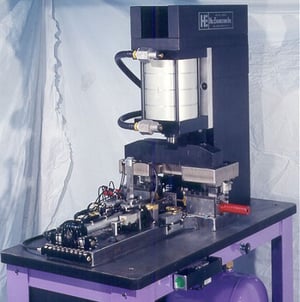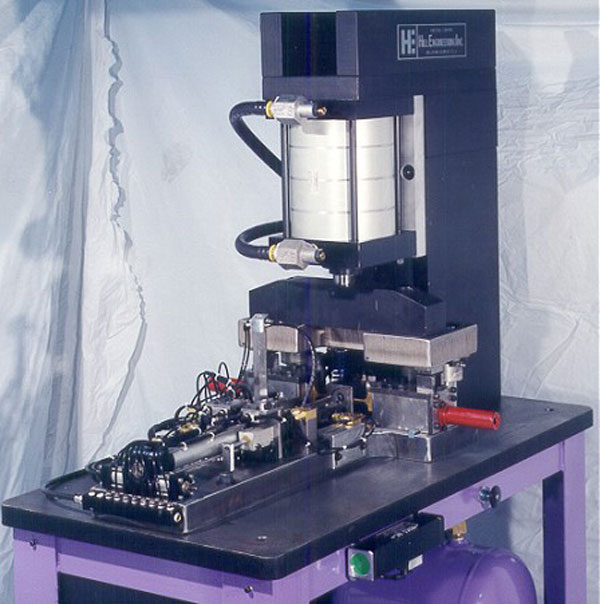Specific Design Principles for Blade-Cut Dies
The cut-off blade should always be guided in flexing into the die sections and shearing. The stripper should be relieved in that area up and bind in the stripper.
Slug pulling can be a serious problem in a flying die. You should always relieve the die sections 1/32 inch deep to within 1/16 inches to 1/8 inches of the cut edge (depending on the thickness to be cut). Therefore, if the slug is pushed beyond this lip, each slug will drop completely through the die and not run any risk of pivoting into the die opening.
Most of the time, many different sized shapes are run through the same line and press. Many times, we must cut the part with a blade, and yet there is not enough room between the slides to let the slug drop. This is solved easily enough by breaking the slug so that two or more piece can fall through the die where one could not. To avoid, at least in part, the biggest problem with blade dies—blade gaulling—one can sometimes “shuttle” the blade sideways to sever a high-leg cleanly without running down the full length of the leg. This can be done with cam action and with the blade being shuttled while traveling down through the part. The die is more expensive initially, but die downtime due to blade wear is only a fraction of what it blade action.
To avoid, at least in part, the biggest problem with blade dies—blade gaulling—one can sometimes “shuttle” the blade sideways to sever a high-leg cleanly without running down the full length of the leg. This can be done with cam action and with the blade being shuttled while traveling down through the part. The die is more expensive initially, but die downtime due to blade wear is only a fraction of what it blade action.
Another method to minimize gaulling is to surface treat the blade—Titanium Nitride, Titanium Carbide, Nitride, and Graphitic Chrome, or retreat with cryogenics. In addition, lubrication is critical to long blade life.
For tubing dies, there are both conventional straight up and down blade dies and swing blade dies. If a tube is hit correctly in the proper location, it will be somewhat self-supporting and collapse only a small amount. The die sections should be cammed-in tightly around any tubing to keep it from flaring out to the die walls. After the cut, the die sections spread only about 1/32 inches to 1/6 inches and the tube passes freely through.
With square, rectangular, and lockseam tubing, a “swing blade” is sometimes incorporated to hit the tube in a self-supporting area. If hit properly, the tube will tend to collapse much less.
To help the blade gaulling somewhat, try to go a full 10-15 percent per side die cutting clearance. This takes some of the tremendous side pressure off the blade.
If no distortion is required on the tube, you may have to:
- De-dimple the tube in a secondary operation
- Provide a cut-off blade access opening in a prenotch die (which may also require a pick-up opening)
- A dimple-free cutoff die that scarfs the top of the tube (horizontally) with a side action blade (that simulates a prenotch)
Then, the main cut-off blade goes down (vertically) through the scarfed opening and finishes the cut.
Specific Design Principles for Crop-Off Dies
Four basic types of blade construction are commonly used today in cropoff dies. One method is to make the entire blade, both moveable and stationary, out of tool steel. The solid blades then slide in the gibs on this same tool steel, needing no inserts for wear plates.
A second method is to make the actual cutting inserts thinner, and smaller overall, than the solid tool steel type of blade, and then insert these into a prehardened or hardened holder. This holder then slides up and down in the side gibs.
The third method is to use a more standard post-type die set using four leader pins and guide bushings in a die shoe and punch holder, making the blade contour the same as the piece part, since we are using only an incoming set of die sections, no slug is taken out. And fourth is a self-contained hydraulic pocket-type die that takes the second method, but now we mount a hydraulic cylinder at the desired angle. With this option, there is no need for a press since a hydraulic power unit will cycle the cylinder/die.
Crop Blade Construction
With the solid-tool steel-blade construction, the stationary blade is backed up by a solid upright. The movable blade is screwed and doweled to a front plate/spring bar, which holds the split sections together and backs up the blade too.
In this day of faster changeovers, necessitated by high labor costs and the need or high production, the solid-blade construction has an advantage. Inserts can be changed quickly by simply taking the blade stops off and sliding the blades out the top of the die. In some cases, the stationary blade must be detached from the upright before it can be reworked.
General Construction
Cut Angle
The first thing that must be done in designing a crop-off die is to determine the angle of the cut. In some cases, such as a part with all 90-degree bends, the cut angle is not critical but it is best at 45 degrees. With a 45-degree angle, we tear the least amount in the corner radii. Some companies request a 60-degree angle for less wear and tear on the die caused by shock. Under most conditions, the cut will be good enough.
To determine the best cut angle, take the average angle of all the legs, add experience, and use this as the cut angle.
Timing
The timing and fitting of the cut is the key to making a slugless die work well with little or no distortion. The speed at which a certain area of the contoured opening is closed up, relative to the area around it, depends entirely on the angle at which the blade is coming through that area. Experience dictates how each case is dealt with.
If a part is distorted when cut with a crop die, it is distorted because the fit and/or the timing is wrong—not simply because it is cutting slug less.
This points out another good reason to section the blades and grind in after hardening. To develop the timing, a person usually has to regrind certain edges. The best way to do this is to first make a test cut to see where the deformation is, if any. Then, take the blades apart and grind out where necessary.



